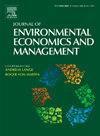“Size-dependent” environmental regulations and spatial labor allocation
IF 5.9
3区 经济学
Q1 BUSINESS
Journal of Environmental Economics and Management
Pub Date : 2025-04-10
DOI:10.1016/j.jeem.2025.103158
引用次数: 0
Abstract
Rich evidence shows that the large and more developed cities in China (as in many other countries) enforce stricter environmental regulations. On one hand, stringent regulations have negative impacts on the local labor market, leading to labor outflow into small cities with lower productivity and “dirtier” industrial structure. On the other hand, better environment quality (as a result of the regulations) is also an attraction for domestic immigrants. This paper is the first to use a quantitative spatial model to study the consequences of spatially “size-dependent” urban environmental policies. We find that higher aggregate productivity and fewer total emissions can be simultaneously achieved by reducing the existing “size-dependent” variation of environmental regulations in China. Moreover, to meet a given overall abatement target, urging the largest cities to further tighten the regulations may do the most damage to the economy.
“规模依赖”的环境规制与空间劳动力配置
丰富的证据表明,中国(与许多其他国家一样)的大城市和较发达城市实施了更严格的环境法规。一方面,严格的法规会对当地劳动力市场产生负面影响,导致劳动力流向生产率较低、产业结构 "更脏 "的小城市。另一方面,较好的环境质量(法规的结果)也会吸引国内移民。本文首次使用定量空间模型来研究 "规模依赖型 "城市环境政策的后果。我们发现,通过减少中国现有的 "规模依赖型 "环境法规差异,可以同时实现更高的总体生产率和更少的排放总量。此外,为了实现给定的总体减排目标,敦促最大的城市进一步收紧法规可能会对经济造成最大的损害。
本文章由计算机程序翻译,如有差异,请以英文原文为准。
求助全文
约1分钟内获得全文
求助全文
来源期刊
CiteScore
8.00
自引率
4.30%
发文量
91
期刊介绍:
The Journal of Environmental Economics and Management publishes theoretical and empirical papers devoted to specific natural resources and environmental issues. For consideration, papers should (1) contain a substantial element embodying the linkage between economic systems and environmental and natural resources systems or (2) be of substantial importance in understanding the management and/or social control of the economy in its relations with the natural environment. Although the general orientation of the journal is toward economics, interdisciplinary papers by researchers in other fields of interest to resource and environmental economists will be welcomed.

 求助内容:
求助内容: 应助结果提醒方式:
应助结果提醒方式:


